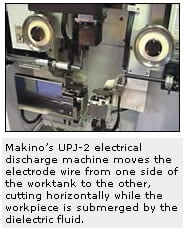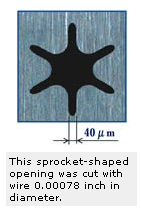Wire EDM (electrical discharge machining) has been configured with the wire in a vertical orientation for decades, so the appearance of a wire machine that orients the wire horizontally is truly a novel development. One such machine, the UPJ-2 horizontal wire EDM, was introduced to the North American market at IMTS by Makino (U.S. headquarters: Mason, Ohio). However, looking beyond the novelty of its wire orientation, the machine is more properly noted for being designed to meet the special needs of micro-miniature machining applications. This is not a general-purpose wire machine reconfigured to hold the wire in an unexpected position. Rather, the company says, it is a piece of equipment specifically engineered for the machining of micro gears used in miniature molds, fiber optic components, inkjet nozzles and medical instruments. The demands of these applications dictated the horizontal wire and other features.
 Although the horizontal wire is the most conspicuous feature of the machine, its ability to handle extremely fine wire may be more significant. Wire as small as 0.00078 inches (0.02 mm) in diameter can be effectively used. (As John Shanahan, a product manager at Makino’s Auburn Hills, Michigan, technical center points out, wire this small is only two and a half times the diameter of a human blood cell.)
Although the horizontal wire is the most conspicuous feature of the machine, its ability to handle extremely fine wire may be more significant. Wire as small as 0.00078 inches (0.02 mm) in diameter can be effectively used. (As John Shanahan, a product manager at Makino’s Auburn Hills, Michigan, technical center points out, wire this small is only two and a half times the diameter of a human blood cell.)
Working with wire this fine posed two main mechanical challenges for the machine’s designers. Automatic wire threading is particularly difficult with wire this fine. The challenge was met with a tubular system that uses positive and negative air pressure to automatically thread a 0.00078-inch wire through a 0.0019-inch (0.05 mm) diameter start hole. Essentially, a vacuum force sucks the wire into the start hole. V-type wire guides, rather than round guides, enhance threading reliability.
The other challenge for designers was wire tensioning. The machine uses a system that automatically applies weights to the wire. Thus, the unvarying force of gravity ensures that tensioning will remain constant during operation.
 According to Mr. Shanahan, these solutions do not make the machine complex or difficult to run. The machine, he says, is as simple to set up and operate as a conventional wire machine.
According to Mr. Shanahan, these solutions do not make the machine complex or difficult to run. The machine, he says, is as simple to set up and operate as a conventional wire machine.
Nevertheless, the horizontal wire provides major benefits in fine-wire, ultra-precision applications. It allows workpieces to be held in an inverted position in the C-axis spindle mounted in the head of the machine. Workpieces can be mounted on standard holders, such as the Erowa pallet system, which lend themselves to automated or robotic loading and unloading.
More importantly, the C-axis rotary motion can be coordinated with X and Y moves to cut intricate geometries. Likewise, slug and core management (a perennial headache in conventional wire EDM) is greatly simplified. An automatic core and slug removal unit allows material to fall away from the workpiece without interfering with the cutting action of the wire or damaging the workpiece. Because fine wire has a limited current carrying capacity, its metal removal speed is proportionately paced, making automation essential for extended operation.
The machine has a granite base like that of a coordinate measuring machine to damp vibration and minimize thermal effects. The machine is fully enclosed to provide a machining environment that can be controlled to within 1°F (0.5°C). Travels in X, Y and Z are 7.87 by 7.78 by 2.36 inches (200 by 200 by 60 mm), with U- and V-axis travel at ±0.394 inch (±10 mm). Maximum weight of workpiece and holder is 44 pounds.
Courtesy of Modern Machine Shop, November, 2004 Issue

